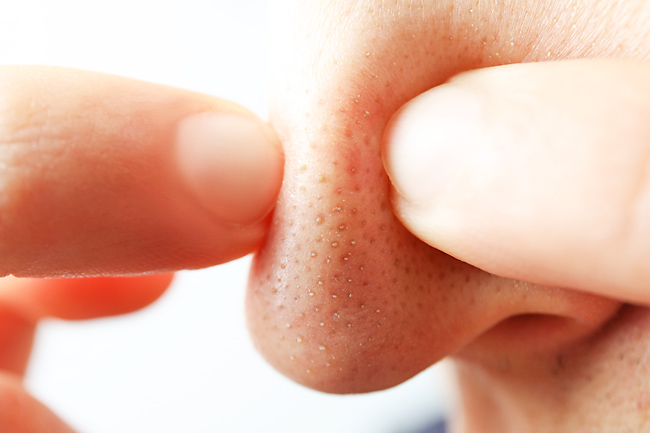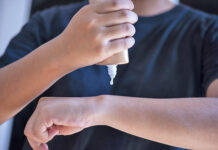Stacey Colino
THE WASHINGTON POST – It seems like a cruel trick from Mother Nature – At a time when you’re becoming concerned with fine lines and wrinkles on your face, you find yourself dealing with acne breakouts, too.
This has become a noteworthy phenomenon during the coronavirus pandemic. A study in the December 2021 issue of the Journal of Cosmetic Dermatology evaluated acne in 172 physicians during the pandemic and found that 45 per cent reported their acne worsened, 27 per cent reported relapses and over seven per cent indicated that they had acne for the first time.
Dermatologists are seeing similar trends among their patients. Recently, “I’ve been seeing more acne in adults, predominantly in women, than I had in the last 15 years,” said associate professor of dermatology at Mount Sinai Hospital in New York City Joshua Zeichner.
Although it’s often thought of as a teenage affliction, adult acne has long existed.
“Acne is unpredictable – it does what it wants whenever it wants,” said dermatologist and clinical psychologist in Yardley, Pennsylvania Rick Fried. “We have zero predictors of when people will outgrow adult acne and what the trajectory of its course will be.”
Still, some of the recent boost in blemishes can be traced to the pandemic, experts said.
Friction from masks, for example, can cause a type of blemish called acne mechanica, while the trapping of exhaled breath, oil, and humidity can lead to other breakouts.

“It’s an environment where heat, moisture and humidity mix with surface oils and whatever else is on your face – it’s almost like a greenhouse effect (for pimples) under the mask,” explained associate professor of dermatology at Weill Cornell Medicine/New York-Presbyterian Hospital Diane Berson.
Our faces aren’t used to being covered with a mask, which “increases moisture (and) traps dead skin cells and bacteria on the skin”, added an associate professor of clinical dermatology at the Keck School of Medicine of University of South California Nada Elbuluk.
Another factor is stress from the pandemic. When your body and mind experience stress, levels of the hormone cortisol increase, which stimulates the skin’s sebaceous glands to produce more oil. Stress also activates the immune system, which promotes inflammation.
More oil and more inflammation can trigger acne flare-ups, said medical adviser Zeichner.
In addition, lifestyle factors such as diet may be playing a role in recent breakouts. During the pandemic, “our whole way of living was shut down and dietary habits for the most part got worse, not better”, Zeichner noted.
A review of studies in a November 2021 issue of the International Journal of Environmental Research and Public Health found that during the pandemic, people increased their snacking frequency and ate more sweets and ultra-processed food (such as sodas, frozen food, chips and salty snacks, cookies, cakes and sugary breakfast cereals).
Research has found that a high-glycemic index diet – one filled with sugary and processed food, which cause blood sugar levels to spike – may be an acne trigger.
When blood sugar spikes, it increases inflammation and oil production in the skin, leading to acne breakouts, Zeichner explained.
By contrast, consuming fruits, vegetables, legumes, steel-cut oats and food rich in omega-3 fatty acids (such as fish, seafood, nuts and seeds), which keep blood sugar level, is associated with improvements in acne.
While it’s possible to adjust your diet, stress and masks aren’t going to disappear from our lives anytime soon. So what to do about acne?
Mild cases can be addressed with over-the-counter cleansing or treatment products that contain benzoyl peroxide, salicylic acid, or retinoids – but “nothing works overnight”, said Elbuluk, who is also the director of the USC Skin of Color Program and Pigmentary Disorders Clinic.
“For many people, over-the-counter products alone don’t suffice. If you’re not getting improvements in six to eight weeks, see a board-certified dermatologist.”
Dermatologists have a larger and stronger arsenal of weapons to combat acne over the long-term, though the approach will depend somewhat on which factors are contributing to someone’s acne.
For hormonal acne (related to the menstrual cycle or perimenopause), there’s a new topical cream that uses clascoterone, an androgen blocker, that can be used by women and men.
“This is a first-in-its-class topical androgen that’s absorbed into the skin,” Fried explained. “It doesn’t have systemic effects. It doesn’t affect the production or level of hormones in the body.”
For non-hormonal acne flare-ups, topical treatments include antibiotics (such as dapsone or clindamycin), retinoids (such as tretinoin, tazarotene and adapalene), and newer combination products such as a benzoyl-peroxide-clindamycin preparation and a benzoyl-peroxide-tretinoin blend.
If you apply topical retinoids, there’s an increased potential for irritation, so it’s important to also use a hydrating agent such as a moisturiser that contains ceramides, niacinamide or hyaluronic acid, Berson said. “You want to maintain the skin’s barrier function if you’re prone to acne breakouts.”
Women who are prone to acne also should use oil-free foundation if they wear makeup – and wash it off well at the end of the day, advised Berson.
Also, “wash your pillowcases regularly, at least once or twice per week”. Don’t wear disposable masks for multiple days in a row, Elbuluk warned, and be sure to wash cloth masks regularly.
Medication for persistent acne triggered by hormonal fluctuations include oral contraceptives, which can put hormones on a more even keel, leading to fewer breakouts.
Another option is spironolactone (a prescription diuretic), which blocks the androgen receptors on the sebaceous glands, causing them to stop producing as much oil, Zeichner said. However, spironolactone can lower testosterone levels.
Oral antibiotics, especially from the tetracycline class, have long been used to treat recalcitrant acne, but this approach brings concerns about disruption of the gut microbiome and the development of antibiotic resistance.
A newer antibiotic called sarecycline, a narrow-spectrum form of tetracycline, is as effective as doxycycline in treating acne, Fried said.
And research has found that sarecycline doesn’t affect gut bacteria the same way that doxycycline or minocycline do. For severe acne that’s prone to scarring, oral isotretinoin may be an option.
Given the influence that stress can have on acne, it’s wise to take steps to reduce or relieve stress in your life.
“We don’t know what an individual’s threshold is for stress where it elicits enough inflammation to cause the appearance or persistence of acne,” Fried said.
“Anything that is stress-reducing may help lessen the severity of acne and improve the effectiveness of treatments.”
The key is to find what works for you – whether it’s exercise, yoga, meditation or other relaxation techniques – for the sake of your skin, as well as the rest of your body and mind.



















































